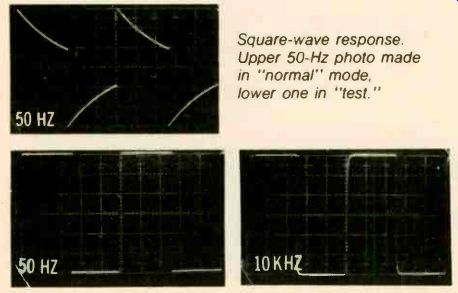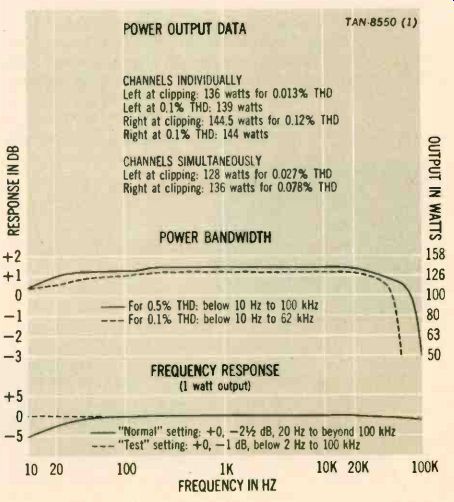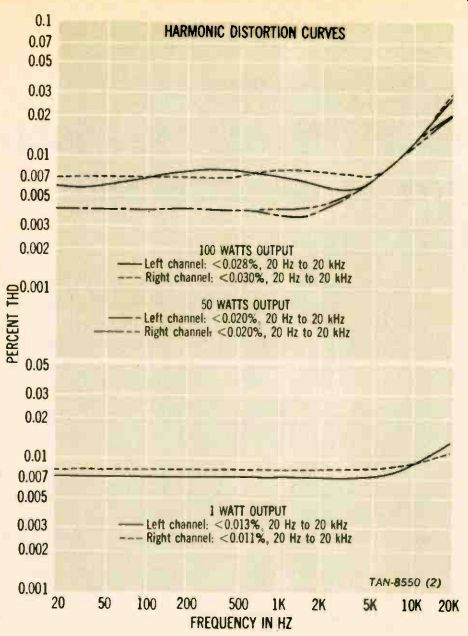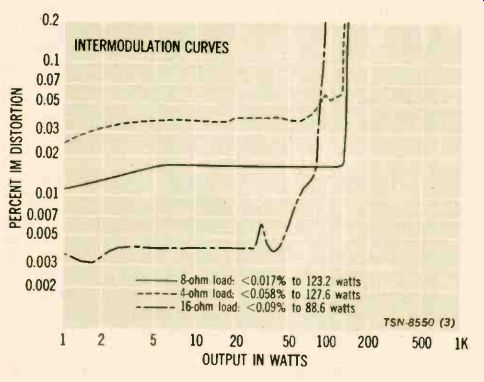
Sony's Luxurious Vertical-FET Power Amp-A First
The Equipment:
Sony Model TAN-8550, a basic stereo power amplifier in metal case with wood ends.
Dimensions: 17 3/4 by 6 1/2 inches (front); 15 3/8 inches deep plus allowance for controls and connections.
Price: $1,000.
Warranty: two years, parts and labor.
Manufacturer: Sony Corp., Japan; U.S. distributor: Sony Corp. of America, 9 W. 57th St., New York, N.Y. 10019.
Comment: FETs, long the darlings of preamp and FM tuner design, now are making it in power amplifiers thanks to the so-called vertical FET, which can handle far more current than conventional FETs. Sony was not the first (nor the last) company to announce an FET amp for high fidelity purposes, but to our knowledge it was the first to produce one. There are, in fact, two: the present model and the TA-4650 integrated amp.
The basic claim made for FETs and V-FETs vs. bipolar transistors is basically similar to that frequently made for tubes vs. transistors (which, until now, has meant strictly bipolar transistors in power circuits): that their broad area of linear response makes possible circuitry of extremely low inherent distortion without massive "corrective" feed back and that their wide dynamic range passes instantaneous peak "overloads" with less trouble.
The distortion in the TAN-8550 is indeed extremely low-so low that it puts a severe premium on the quality of the test equipment used to document it. CBS Labs measured nothing higher than 0.03% THD at the rated 100-watt output and at any frequency! At 1% of rated power the measured distortion (which in many amps is driven up at low power by noise content in the output) is virtually identical to that at full power; at half power midrange distortion is lower still. IM, too, is extremely low. With an 8-ohm load it remains below 0.02% over the entire operating range and actually drops to half this figure at the minimum output tested by the lab (0.125 watt). As usual in solid-state amps, IM is a little higher with a 4-ohm load, a little lower into 16 ohms; but all of the IM measurements made by the lab are below 0.1%! The operating controls are somewhat unconventional.
The front panel has an on/off pushbutton with a built-in pilot light. Near it is a peak-reading light-beam metering system similar to that of the TAE-8450 preamp (HF test re port, March 1975), but without its multiple-mode (including peak-hold) options. Below, in a recessed section of the front panel, are a rotary speaker selector (B/off /A/A + B), a level control that is used only for the B output when it is used alone, meter-sensitivity buttons: "X 1," which shows output-level values from 1 to 200 watts, and "X 1/10" for use at lower levels and measuring outputs between 0.1 and 20 watts. Meter calibration is for 8-ohm loads. Since the meter essentially responds to output voltage, rather than to power itself, correction must be made for other load impedances, as explained in the exceptionally good owner's manual. At the right are separate level knobs for each channel and affecting all positions of the front-panel selector. That is, the knob for the B output is in series with these separate knobs; when it is at full rotation the B out put still is attenuated by the separate knobs.

------ Square-wave response. Upper 50-Hz photo made in "normal" mode,
lower one in "test."

----------POWER OUTPUT DATA

------ HARMONIC DISTORTION CURVES

----------INTERMODULATION CURVES
-----------
Sony TAN-8550 Amp--Additional Data
Damping factor: 157 ("direct") 80 ("A" output)
Input characteristics (for 100 watts output)
Sensitivity S/N ratio 1.0V 105 db
-----------
Actually, however, there are three sets of speaker terminals (a positive-latching design, suitable for bared-wire leads, that we had not seen before) on the back panel: A, B, and "direct." The direct feed is live at all positions of the front-panel selector switch (even "off"); when that switch is in the B position the direct feed, like that for the B speaker pair, is affected by the B-speaker level control.
Thus if you want to disable all speakers (perhaps for head phone listening) you can use the A and B connections alone; if you always have your main speakers on you can connect them to the direct output and run extensions off A and B; if you're such a purist you need two pairs of speakers for either/or use (depending on the type of music), you can connect the less efficient pair to A and use B for the more efficient pair, compensating for the efficiency difference at the B level control. The direct connection, because it bypasses the inherent resistance of the speaker switch contacts, yields a slightly higher damping factor (see "Additional Data") than the other outputs; but, at 80, even their damping factor is ample. (Anything above, say, 40 is considered high.) If, however, you plan to use all connections simultaneously--or even two sets-be warned: The combined impedance should not be below 4 ohms-meaning that even three 8-ohm pairs are out since that combi nation results (as the owner's manual explains) in a net of 2.7 ohms.
The back panel has an unswitched convenience outlet.
Because of the power levels of which the TAN-8550 is capable and its current drain, Sony says it should be plugged directly into a wall outlet--not into a convenience outlet on another component. But any component powered via the amp must have its own on/off switch, of course.
Also on the back panel are two pairs of inputs ("1" and "2"), each with its own "normal"/"test" switch. Pushbuttons at the upper right of the front panel select between the two inputs. In the normal positions a subsonic filter is inserted into the input circuit; the test position delivers flat subsonic response. At 2 Hz the lab still found the 1-watt response to be dead on the 0 dB mark! Obviously such phenomenal subsonic response can be dangerous to your speakers if your preamp is capable of delivering (for example) RIAA-boosted rumble and warp information in that range; hence the "normal" designation for the filtered position--which the lab used for all measurements not specified as made in the "test" mode.
No two ways about it: This is a superb amplifier. It can be driven into clipping if your speakers and your ears will handle that much power (128 watts was the lowest clip ping figure the lab clocked). And a comparison between the 0.1% and 0.5% (THD) bandwidth curves shows that distortion is rising fairly rapidly as the ultimate power of the amplifier is reached-but not quite as fast as it is in many super-amps, meaning that the Sony has a hair more overload toleration. In this class of equipment, of course, HIGH FIDELITY'S standard 0.5% distortion point represents outright abuse. As a practical matter, using typical ancillary equipment and reasonable (if loud) playback levels, we could find nothing whatever to fault in the sound. It is exemplary. We assume the VFET to contribute materially to this quality; if that assumption is justified by future product developments, we have a lot of good listening to look forward to.
-----------
The "head amp" that isn't: The Sony TAE-8450 Preamp Revisited
Last March, in reviewing the preamp from the new premium Sony separates line (which also includes the power amplifier reviewed here), we commented on what Sony calls the preamp's "head amplifier" and which for that reason we took to be designed for use with direct feed from a tape deck's playback head. It is not.
It is intended as what is variously called a pre-preamplifier or a microamp--an amplification device for use ahead of the normal phono preamplifier with phono pickups of ultralow output. Unless given the extra boost-which may, alternatively, be supplied by a matching transformer--these signals are insufficient to drive the preamp (and hence the power amplifier) to rated output. They are, in other words, below the sensitivity rating of a normally-designed preamp.
A few companies (notably Ortofon) have offered such pickups over the years, and Sony evidently felt that a complete state-of-the-art preamp should allow-via built-in electronics--for their use. Hence its provision of the extra gain and the switchable input impedance to encompass the needs of virtually any such pickup. To repeat: The feature is not intended for use with tape heads, and our statements based on the assumption that it was are incorrect.
-------------
(High Fidelity, Jul. 1975)
Also see:
Onkyo A-7 Integrated Amp (Equip. Profile, Nov. 1977)
Equipment in the News (Jan. 1976)